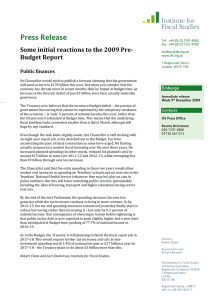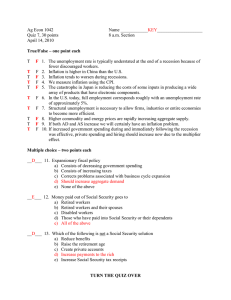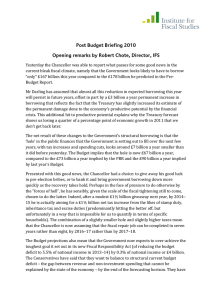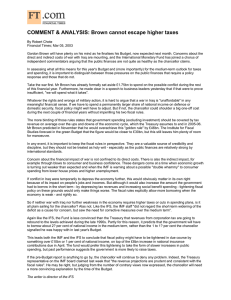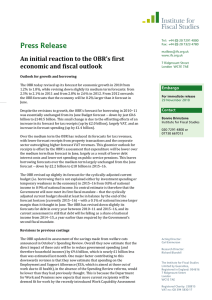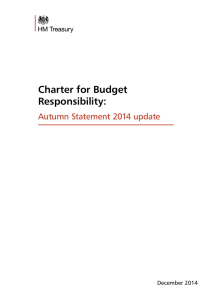The big news is the old news
advertisement
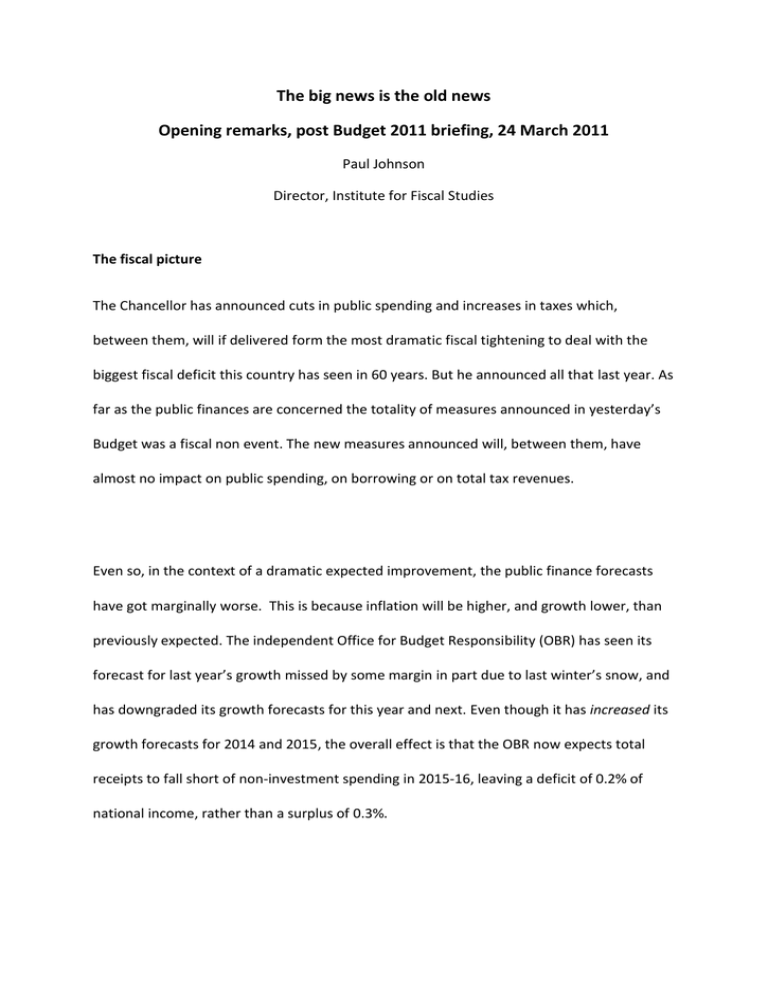
The big news is the old news Opening remarks, post Budget 2011 briefing, 24 March 2011 Paul Johnson Director, Institute for Fiscal Studies The fiscal picture The Chancellor has announced cuts in public spending and increases in taxes which, between them, will if delivered form the most dramatic fiscal tightening to deal with the biggest fiscal deficit this country has seen in 60 years. But he announced all that last year. As far as the public finances are concerned the totality of measures announced in yesterday’s Budget was a fiscal non event. The new measures announced will, between them, have almost no impact on public spending, on borrowing or on total tax revenues. Even so, in the context of a dramatic expected improvement, the public finance forecasts have got marginally worse. This is because inflation will be higher, and growth lower, than previously expected. The independent Office for Budget Responsibility (OBR) has seen its forecast for last year’s growth missed by some margin in part due to last winter’s snow, and has downgraded its growth forecasts for this year and next. Even though it has increased its growth forecasts for 2014 and 2015, the overall effect is that the OBR now expects total receipts to fall short of non-investment spending in 2015-16, leaving a deficit of 0.2% of national income, rather than a surplus of 0.3%. But it is not just lower growth that has resulted in these less optimistic public finance forecasts. High inflation is an even bigger culprit as it feeds through directly into higher social security payments, payments of public sector pensions and debt interest repayments. The Chancellor can take some comfort, though, from the fact that the OBR has not changed its estimate of potential output and potential growth. As a result, its forecast of the cyclically adjusted deficit – that is, the amount of borrowing that is thought to be impervious to economic recovery – has hardly changed. The OBR is still forecasting a cyclically adjusted current surplus of 0.4% of national income by 2014-15. And it is this cyclically adjusted measure which the Chancellor is targeting in his “fiscal mandate”. As the OBR itself acknowledges, the biggest threat to the public finances is “the possibility that we have over-estimated the amount of spare capacity in the economy, now or in the future”. In other words, the forecasts are now even more dependent on a bounce back in the rate of economic growth from 2013. Given these forecasts it is clear why the Chancellor, sticking to his deficit reduction plans, did not feel able to engage in a net giveaway. Going forward he is going to be uncomfortably dependent on the judgments that the (independent) OBR makes over the (unobservable) potential output of the economy. We all need to hope that the OBR proves a better forecaster of the public finances than it has been of the weather. Spending and taxing We will see big changes to our incomes and our public services over the coming years, though not as a result of yesterday’s measures. Higher inflation however not only affects the public finances but also means that cuts to public services are bigger than they would have been, and could be harder to deliver. Simply because inflation is turning out higher than expected, real cuts to public service spending are now on course to be, on average, one percentage point greater over the next four years than was announced in the spending review. In terms of the government’s pledge to grow NHS spending in real terms year on year, this is now expected to be only barely met between 2010-11 and 2011-12. And then only because of a possible under-spend and the fact that they are comparing to actual spending in 201011, rather than a figure which takes account of temporary measures. At the time of the Spending Review the government used this figure including temporary measures as the comparator for all departments. If 2010-11 spending had been in line with the spending review baseline, then there would have been a small real cut in 2011-12. The government is meeting its pledge, but is sailing perilously close to the wind. With regard to household incomes, these will fall by about two and a half per cent, or £750 a year, as a result of changes (including January’s VAT rise) implemented this year. The richest households will be hardest hit. Over the whole parliament tax and benefit changes will hit household incomes to the tune of more like five per cent or £1,500 a year. Little changed as a result of yesterday’s announcements. Easily the most expensive thing that Mr Osborne did do yesterday was to cut duties on petrol and diesel, and abolish the 1% above inflation escalator on fuel duty. The political pressures that led him to this policy are clear. At some point, though, he is going to have to offer a long-term strategy for the taxation of the motorist. He is following a path welltravelled by his predecessors by not implementing previously planned duty increases. The effect, especially as cars become more efficient, is a continuing reduction in the tax per mile driven: this alone led the OBR to revise down forecast revenues from fuel duties in 2015–16 by £0.5bn compared to what they expected in November. In the long run we will have to find a sustainable way of taxing drivers, not least to reflect the costs they impose on others. This less-than-green reduction in real fuel duties was accompanied by what is actually a rather radical green tax change – the introduction of a carbon price floor. By underpinning the price charged through the European emission trading scheme this will provide long-term certainty to electricity generators which should help them make long-term investment decisions. It will also lead to higher fuel bills for households. The other major focus for tax reform for households was once again on increasing the taxfree personal income tax allowance. Not only will this rise by £1,000 to £7,475 this April, but we now know that it will go up by a further £630 in April 2012, or £240 more than a rise in line with inflation would have warranted. This is another step towards the government’s ambition for a £10,000 allowance. It remains a progressive way of cutting income tax bills. One thing is perhaps slightly odd, though, in light of the Chancellor’s welcome commitment to integrate the operation of income tax and National Insurance. He is not extending to NI the principle of increasing the point at which tax starts to be paid. Instead, along with other tax thresholds, the point at which NI starts to be paid will now rise more slowly in future, no longer rising in line with the RPI but rather being linked to the (generally lower) Consumer Price Index. The gap between the point at which people start to pay NI and the point at which they pay income tax will grow. The more general implication of this rather arcane change is that fiscal drag will now have an even greater impact on the tax take. Of course this was also heralded by the Chancellor as a Budget for Growth. He is investing heavily in cuts to corporation tax adding a further 1p cut to the series of cuts announced last year such that by 2014-15 the main rate will have fallen from 28% to 23%. This is a substantial cut which should have some impact on corporate activity in the UK. Conclusions This budget could never match up to the scale of last year’s two extraordinary fiscal events – the June Budget and the October Spending Review. In terms of the fiscal plans it is steady as she goes. But risks to the plans are already beginning crystallise in lower predicted growth and higher predicted inflation. And this higher inflation means that, in real terms, the cuts in public spending will be even more dramatic than planned. Specific reforms are also relatively modest. There are some welcome changes to carbon taxation and some nods towards tax simplification. But there is perhaps less in the way of a long term strategy for tax reform than one might have hoped. The plan for growth again contains some potentially valuable elements, but alongside an awful lot of bits and pieces which promise to increase complexity in some areas just as the Chancellor looks to reduce it elsewhere.
